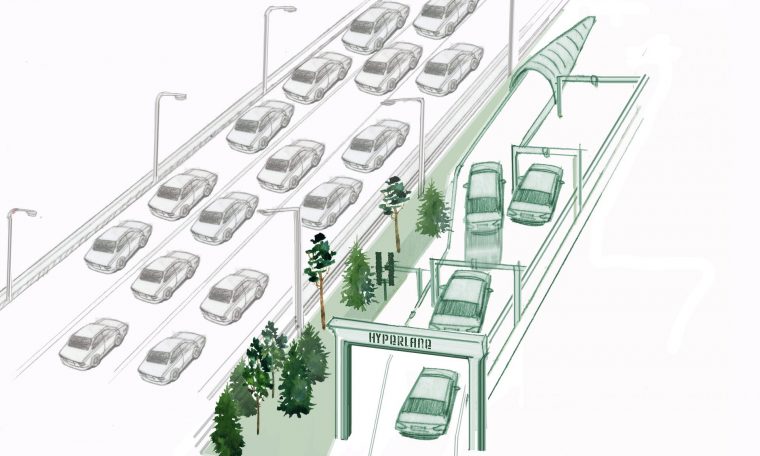Hyperlane: a New Automotive Technology with the Potential to Reduce Traffic

Hyperlane
Photo: Anthony Barrs and Baiyu Chen
According to The Telegraph, the average driver spends around 32 hours stuck in traffic jams each year. Some predict that self-driving cars would make traffic worse. Others say that the cars would improve traffic, with their unique maneuverability and a pre-programmable option to not tailgate other cars. Two Berkeley grads, Anthony Barrs and Baiyu Chen, add to that conversation with their Hyperlane idea that would significantly reduce traffic by incorporating self-driving cars into a new automotive technology. They recently won top honors for their concept at Association of Equipment Manufacturers’ Infrastructure Vision 2050 Challenge.
Exactly how does Hyperlane work? If a person has a self-driving car and finds themselves stuck in traffic, they could tap into the system’s central computer to navigate the car into a special accelerated, lower-congestion lane that would be designated for only self-driving cars. Barrs and Chen compare the computer to an air traffic control center. Once in this lane, the computer would autopilot the car through traffic using this faster lane. 5G technology would allow the computer to “talk” with each car in the lane to monitor traffic flow and initiate a more compact traffic flow. Cars in the lane could travel up to 120 mph, significantly faster than the conventional traffic lanes.

Some typical LA traffic
Photo: Jeff Turner
The two grads want to target Hyperlane to a few main traffic hubs, for starters, including the Dallas-Ft Worth, San Francisco Bay, and Baltimore-Washington regions. The technology would make traffic a breeze. For example, the trip from Berkeley to Palo Alto can take more than two hours at prime time rush hour. Hyperlane would cut this down to just 40 minutes.
Barrs and Chen are currently marketing their award-winning idea to transportation companies as well as state transportation officials. With Google’s claim to have a self-driving car on the market within the year and other OEMs predicted to sell their own models as early as 2020, one can only hope that new traffic-reducing technologies like Hyperlane will follow.
Sources: The Guardian, The Telegraph, Investopedia

The News Wheel is a digital auto magazine providing readers with a fresh perspective on the latest car news. We’re located in the heart of America (Dayton, Ohio) and our goal is to deliver an entertaining and informative perspective on what’s trending in the automotive world. See more articles from The News Wheel.

